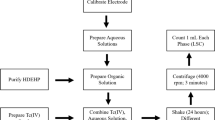Summary
Rate constants are reported for mercury(II)-catalysed aquation of thetrans-[Rh(en)2Cl2]+, [Cr(NH3)5Cl]2+, andcis-[Cr(NH3)4(OH2)Cl]2+ cations in water and in methanol-, ethanol-, and acetonitrile-water solvent mixtures. In the case oftrans-[Rh(en)2Cl2]+, the dependence of rate constants on mercury(II) concentration indicates reaction through a binuclear (Rh-Cl-Hg bridged) intermediate. The dependence of the equilibrium constant for the formation of this intermediate and of its rate constant for dissociation (loss of HgCl+) on solvent composition have been established. With the aid of measured solubilities, published ancillary thermodynamic data, and suitable extrathermodynamic assumptions, the observed reactivity trends for these mercury(II)-catalysed aquations are dissected into initial state and transition state components. The reactivity patterns for these three complexes are compared with those for mercury(II)-catalysed aquation of other chloro-transition metal complexes, particularlycis-[Rh(en)2Cl2]+, [Co(NH3)5Cl]2+, and [ReCl6]2−.
Similar content being viewed by others
References
M. H. Abraham, G. F. Johnston, J. F. C. Oliver and J. A. Richards,J. Chem. Soc. Chem. Commun., 930 (1969).
M. J. Blandamer and J. Burgess,Pure Appl. Chem., 51, 2087 (1979).
M. J. Blandamer and J. Burgess,Coord. Chem. Rev., 31, 93 (1980).
E.g., P. Moore,Inorg. React. Mechanism, 5, 184 (1977);6, 198 (1979);7, 179 (1981); and refs. therein.
V. V. Tatarchuk and A. V. Belyaev,Koord. Khim., 4, 1059 (1978).
M. J. Blandamer, J. Burgess and R. I. Haines,J. Chem. Soc. Dalton Trans., 607 (1980).
J. L. Armstrong, M. J. Blandamer, J. Burgess and A. Chew,J. Inorg. Nucl. Chem., 43, 173 (1981).
J. Burgess and A. J. Duffield,J. Inorg. Nucl. Chem., 42, 1531 (1980).
J. Burgess, K. W. Bowker, E. R. Gardner and F. M. Mekhail,J. Inorg. Nucl. Chem., 41, 1215 (1979).
See,e.g., P. R. Adby and M. A. H. Dempster,Introduction to Optimization Methods, Chapman and Hall, London (1974).
A. Ogard and H. Taube,J. Am. Chem. Soc., 80, 1084 (1958); W. A. Levine, T. P. Jones, W. E. Harris and W. J. Wallace,ibid., 83, 2453 (1961); L. Mønsted and O. Mønsted,Acta Chem. Scand., 28A, 569 (1974).
D. W. Hoppenjans, J. B. Hunt and C. R. Gregoire,Inorg. Chem., 7, 2506 (1968).
L. Mønsted and O. Mønsted,Acta Chem. Scand., 28A, 23 (1974).
W. W. Fee, W. G. Jackson and P. D. Vowles,Austral. J. Chem., 25, 459 (1972).
See,e.g., N. Al-Shatti, T. Ramasami and A. G. Sykes,J. Chem. Soc. Dalton Trans., 74 (1977); and refs. therein.
D. A. Palmer, R. van Eldik, T. P. Dasgupta and H. Kelm,Inorg. Chim. Acta, 34, 91 (1979).
J. H. Espenson and S. R. Hubbard,Inorg. Chem., 5, 686 (1966).
E. g., E. Grunwald and S. Winstein,J. Am. Chem. Soc., 70, 846 (1948); P. R. Wells,Chem. Rev., 63, 171 (1963).
J. Burgess and M. G. Price,J. Chem. Soc. A, 3108 (1971).
J. Burgess and A. J. Duffield,J. Pharm. Pharmacol. to be submitted.
N. Ise, M. Ishikawa, Y. Taniguchi and K. Suzuki,Polymer Lett., 14, 667 (1976).
A. Seidell,Solubilities of Inorganic and Metal Organic Compounds, 3rd. edn., Vol. 1, Van Nostrand, New York, 1940, p. 444.
J. Burgess,J. Chem. Soc. Dalton Trans., 825 (1973).
S. N. Anderson and F. Basolo,Inorg. Synth., 7, 217 (1963).
O. T. Christensen,Z. Anorg. Chem., 4, 229 (1893); M. Mori,Inorg. Synth., 5, 132 (1957).
J. Springborg and C. E. Schäffer,Inorg. Synth., 18, 75 (1978).
A. J. Gordon and R. A. Ford,The Chemist's Companion, Wiley, New York (1972).
M. J. Blandamer, J. Burgess and P. Wellings,Transition Met. Chem., 6, 364 (1981).
P. Moore,Trans. Faraday Soc., 68, 1890 (1972).
J. Burgess,Metal Ions in Solution, Ellis Horwood, Chichester, 1978, chap. 10.
E.g., G. Wittig, G. Keicher, A. Rückert and P. Raff,Annalen, 563, 110 (1949); J. N. Cooper and R. E. PoweU,J. Am. Chem. Soc., 85, 1590 (1963); G. Baum,J. Organometal. Chem., 22, 269 (1970).
R. D. Gillard and G. Wilkinson,J. Chem. Soc., 3193 (1963).
Author information
Authors and Affiliations
Rights and permissions
About this article
Cite this article
Adeniran, A.O., Baker, G.J., Bennett, G.J. et al. Initial state and transition state contributions to reactivity in mercury(II)-catalysed aquation of thetrans-[Rh(en)2Cl2]+, [Cr(NH3)5Cl]2+, andcis-[Cr(NH3)4(OH2)Cl]2+ cations in binary aqueous solvent mixtures. Transition Met Chem 7, 183–187 (1982). https://doi.org/10.1007/BF01035839
Received:
Issue Date:
DOI: https://doi.org/10.1007/BF01035839




